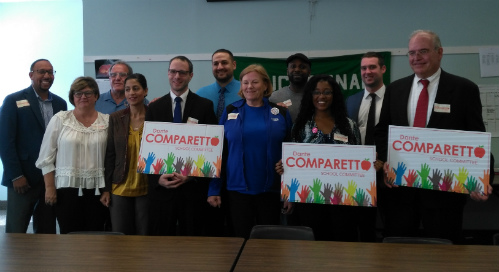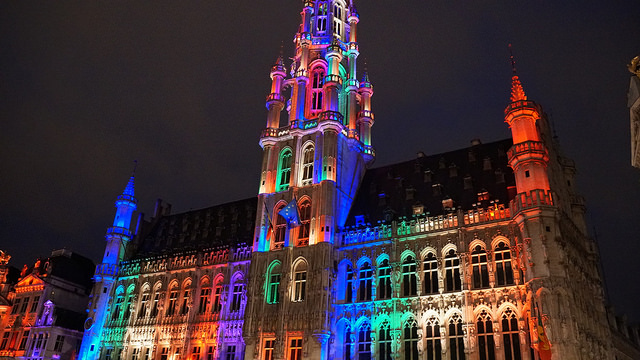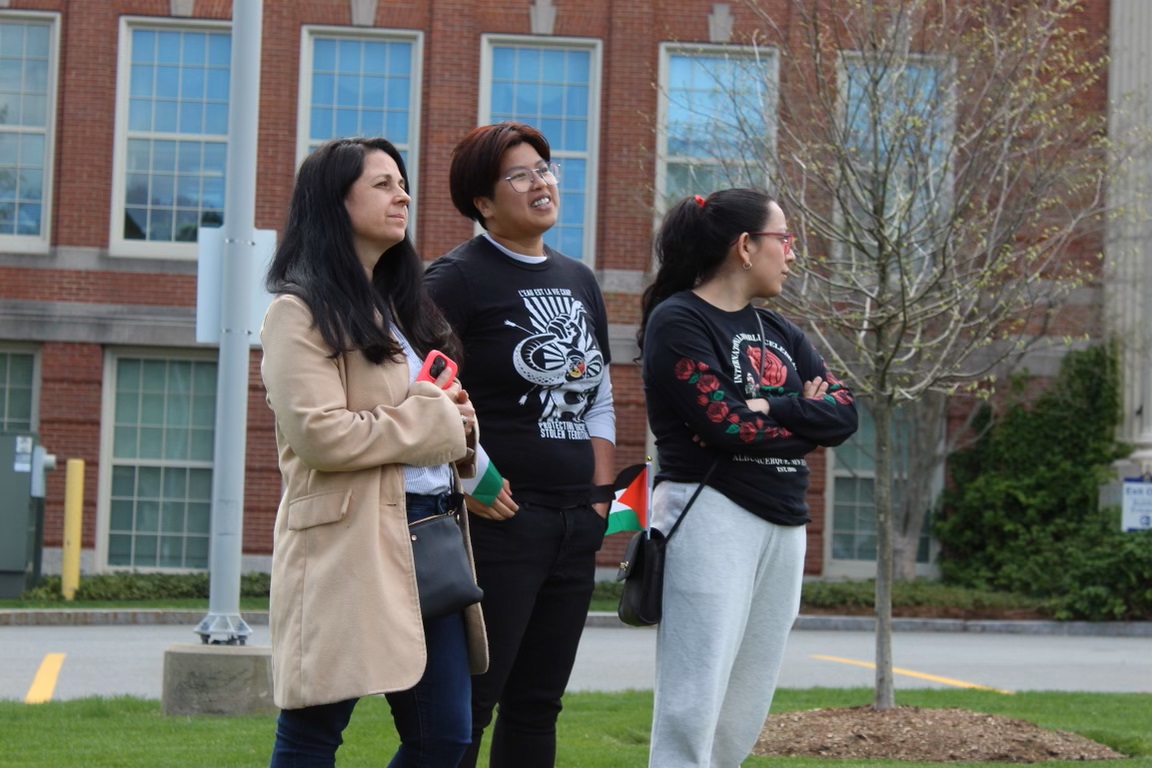UNITED NATIONS—Anna, now 21 years old, was born in the Ukrainian town of Kamenets-Podolsky, then still a part of the Soviet Union. During her early childhood, she led a typical family life and her basic needs were met. She lived with her mother and father, who was an engineer.
Her life began to change radically in 1991, when socialism in the USSR fell apart. Her entire town was plunged into poverty as its main employer shut down. Her family was left jobless, until her father went to work for lower wages as a mason. The transition proved too much for him, and his health declined until, eventually, he died.
With her family life destroyed, Anna became desperate. She struggled on until someone she had met offered her a job working at a hotel in another country. Anna accepted the position in hopes of finding a better life.
Her dreams were dashed, however. After being taken abroad, and after a trip across a desert on a pickup truck, she was locked inside an apartment. There was no hotel job waiting for her, nor was there a hotel. Instead, she was raped up to nine times a day by different men who paid her captors for the sex. Anna had unwittingly become trapped in sex slavery.
Anna eventually escaped, according to the Chasing the Dream [archived site] project, which published her story online. She was lucky. However, countless others around the world are not so lucky.
Forced labor is pervasive
At least 12.3 million people in the world today work in slave-like conditions — and, in many cases, in actual slavery — says a May 2005 report on forced labor by the International Labor Organization (ILO), a United Nations-affiliated group dedicated to labor rights around the world.
Forced labor is “a social evil which has no place in the modern world,” said ILO Director-General Juan Somavia.
Astonishingly, one out of every 500 people on earth and one out of every 250 workers worldwide is a victim of forced labor, according to the ILO. And while 12.3 million people is a whopping portion of humanity, it is likely that this number is understated because countries vary widely in their record-keeping practices.
“Forced labor” conjures up images of brutal regimes such as the Southern slavocracy in the U.S., Nazism in Germany, or Stalin or Pol Pot’s communism. However, the vast majority of forced labor today happens in the private sector, according to the ILO report, which is titled “A Global Alliance Against Forced Labor.”
While 2.5 million people are still forced to work by state or “rebel military groups,” 9.8 million are exploited by “private agents.” Of these, an estimated 8 million are trapped in private sector industries.
“There has been a greater realization,” the report states, “that forced labor in its different forms can pervade all societies, and is by no means limited to a few pockets around the globe.”
UN’s definition
According to the ILO, forced labor comprises two elements: the work is done involuntarily and failure to perform brings a penalty. Examples of what is described as an involuntary activity could range from being born into slavery, to physical abduction and kidnapping, to lies about the type of work to be performed, to forced indebtedness or the withholding of identity documents, such as a green card. Examples of penalties range from physical or sexual violence to loss of rights, food or shelter. “Denunciation to authorities (police, immigration, etc.) and deportation” is also listed as a penalty that would constitute forced labor.
Of the 12.3 million victims, 9.49 million are in Asia and the Pacific region — especially Myanmar (formerly Burma) where state-imposed forced labor is extensive. Latin America and the Caribbean nations account for about 1.32 million people, and the “transition countries” — the former communist states — account for 210,000 people. This number is artificially low, the report notes, as it does not account for human trafficking, where people have been taken from their home country, either by being lured or captured, and forced into labor in a foreign land.
The industrialized nations in Europe and the United States are by no stretch immune from the problem: they account for 360,000 people engaged in forced labor, higher than the Middle East and North Africa (260,000) or the transition countries.
The private profit motive
The report breaks down the labor into different types. The vast majority, 64 percent, represents exploitation for private profit. Another 11 percent is private sexual exploitation, and 20 percent is compulsory state labor. An additional 5 percent is defined as “other.”
The report breaks the numbers down further by sex and age. Non-sexual forced labor is made up of 44 percent men and boys, and 56 percent women and girls. Sexual exploitation, on the other hand, is made up of 98 percent women and girls. Worse yet, the report estimates that children represent “between 40 and 50 percent of all victims of forced labor.”
While the report states that forced labor is a problem in every region of the globe, “the offense … even when recognized under national law, is very rarely punished.” Punishments for those convicted of the practice is small compared with the gravity of the offense, and there is a very low level of awareness worldwide. Forced labor is, the report states, one of the most hidden problems in the world today.
In the economic structure
While punishment and laws are necessary in order to combat these practices, this is not enough. The current structure of the economics and politics in many nations is to blame as well.
“A broad mix of law enforcement, social and economic policies is needed to come to grips with the structural problems of forced labor,” the report concludes. This means reforming much of the “free trade” policies of globalization.
“With globalization you have increased competition, market forces are getting ever tougher,” Caroline O’Reilly, senior specialist on the Special Action Program on Forced Labor at the ILO in Geneva told me. “There are pressures out there to reduce costs, and of course one of the ways that unscrupulous managers will respond to pressures to reduce costs is to exploit their labor force.”
The report dedicates a considerable amount of time to human trafficking.
“When [people] can’t migrate legally, they look for other ways and resort to traffickers and can end up in forced labor,” O’Reilly said.
In U.S. and Europe, high rates of exploitation
While the number of people in forced labor in the United States and Europe is relatively low, the rate of profit stemming from such exploitation is much higher in the industrialized world.
According to the report, the estimated annual profit realized from each forced laborer in Asia who is pressed into sexual work is US$10,000, versus $412 for a worker in non-sexual work. But the corresponding figure for industrialized countries is $67,000 per worker in sexual labor, versus $30,154 per person in other types of labor.
The report carries out the math to its stunning conclusions: contrary to popular expectations, the revenue generated by forced labor is nowhere higher than in the industrialized nations. While the practice brings exploiters in Asia $9.7 billion, it generates $15.5 billion in the industrialized world.
While the report is broken down only by regions, there is overwhelming evidence that the U.S. is plagued by this problem as well.
“We think that there are at least 10,000 people who are actually enslaved in the United States at any given time,” Jacob Patton, director of outreach and technology at Free the Slaves, told me. Free the Slaves is a U.S.-based anti-forced labor organization which, working together with the Human Rights Center at the University of California-Berkeley, produced a report titled “Hidden Slaves,” the first comprehensive study on forced labor in this country.
Patton emphasized that the estimate of 10,000 — like the ILO’s estimate — is a conservative figure, for the same reasons of inconsistent record keeping that the ILO cited in its report.
Patton said that while the stereotypical notions of slavery — brothels in New York’s Chinatown, for example — hold true, the problem is more widespread than that. “They are in several different industries,” he said. “Certainly there are people working in the Southeast and Southwest in agricultural work or industry. There are people enslaved working as domestic servants, and there are people forced to work as prostitutes as well.”
Shining the light on hidden slavery
According to “Hidden Slaves,” the majority of forced laborers were people trafficked in from China, Mexico and Vietnam. However, there are a large number of people who are born into slavery here in the United States. Additionally, many ethnic groups are affected. “Although many victims are immigrants, some are U.S. residents or citizens,” it states.
A case study in the “Hidden Slaves” report illustrates the point. A 13-year-old girl was abducted while waiting at a bus stop in Cleveland, Ohio, and then taken to Detroit, where she was held in a house full of other captive females. She and the others were forced to strip and have sex with male visitors and to sell trinkets at local malls.
The girls were disciplined using a carrot and stick approach. They were not allowed to go anywhere, even within the house, without a chaperone. If they were “good,” they were rewarded slightly. If they were “bad,” they were beaten violently.
The 13-year old girl eventually escaped. In January 2003, when she was taken to a Detroit mall, she ran into a convenience store and begged for help. She led police back to the house, and the perpetrators were arrested and found to have been operating a forced-labor ring since as far back as 1995.
According to the report, “Most of the teenagers reported being so afraid of [their captor] that they did not attend his formal sentencing hearing. Some of [his] victims say they now sleep with nightlights on or crawl into bed with their mothers. Others say they are experiencing emotional problems. One young woman, who was raped repeatedly at the Detroit house, is pregnant.”
Stressing the inhumane nature of the practice, the report continues, “Victims of forced labor have been raped, assaulted and murdered. They have been held in absolute control by their captors and stripped of their dignity. Some have been subjected to forced abortion. … Some have died during their enslavement.”
The report says that in the last five years alone, the press reports have indicated that 19,254 people were found in 131 situations involving forced labor.
“We found incidents of slavery from coast to coast in over 90 different locations throughout the States, and that’s from everywhere from New York and California certainly, but also Texas, areas in the Midwest as well,” he continued. “Slavery and trafficking is the third most lucrative form of organized crime, just behind drugs and weapons trafficking in the world, and that certainly applies to the U.S., too.”
The “Hidden Slaves” report notes that, while the U.S. has a law on the books — the Trafficking Victims Protection Act — federal law does not go far enough in helping those in slavery. Victims of forced labor are scared to come forward because of their “illegal” status, and are wary of talking to authorities. Therefore, most of the work done falls to poorly financed nongovernmental organizations.
The anti-trafficking law has other limitations, as well. By requiring that victims actively cooperate with the authorities, the law “creates the perception that survivors are … instruments of law enforcement, rather than individuals who are … deserving of … restoration of their human rights.”
While UN-affiliated agencies and NGOs within the United States are working to end the practice — with important successes, as in the case of Anna — the problem of forced labor continues to be widespread, and, as activists claim, people worldwide need to step up the pressure on their respective governments to enact measures to end the practice forever.
For more information, visit the ILO web site at www.ilo.org.



